The Economics and Statistics Division maintains archives of previous publications for accountability purposes, but makes no updates to keep these documents current with the latest data revisions from Statistics Canada. As a result, information in older documents may not be accurate. Please exercise caution when referring to older documents. For the latest information and historical data, please contact the individual listed to the right.
<--- Return to Archive
For additional information relating to this article, please contact:
February 10, 2023LABOUR PRODUCTIVITY AND HOURS WORKED, 2021 [REVISED] Statistics Canada has released revised labour productivity accounts for 2021.
The data are consistent with provincial and territorial economic accounts as well as GDP by industry data released on November 8, 2022 and the national GDP by industry data released on November 29, 2022. The revision incorporates revisions from the Survey of Employment, Payroll and hours as well as the Labour Force Survey. The revision also incorporates new data from the 2021 Census of Population, which improves the industrial allocation of the self-employed and estimates of interprovincial flows of workers as well as historical revisions to the incomes of employees. Data reported below focus on business sector industries and do not include either government or non-profit institutions. For example, education refers only to private educational institutions and not government-funded schools.
During 2020, the imposition of widespread restrictions to contain the COVID-19 pandemic resulted in significant declines in hours worked in every province as well as in most business industries. However, the decline in real GDP from business sector industries was much lower than the drop in hours worked - raising productivity substantially in all provinces.
As COVID related restrictions eased in 2021, there was a significant increase in hours worked across many industries without as large a rebound in real GDP. As a result, productivity was down for most provinces.
Nova Scotia's business sector labour productivity fell by 4.0% in 2021, revised down from -3.9%. National productivity was down 5.8% with declines in all provinces except Prince Edward Island. Newfoundland and Labrador reported the largest decline in labour productivity.
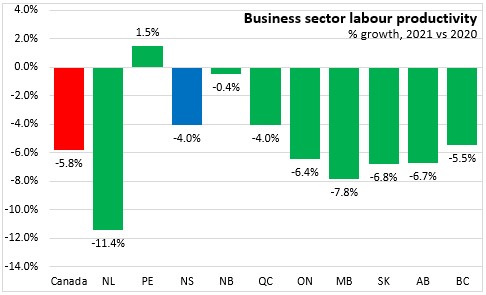
Labour productivity represents the amount of real value added generated per hour worked. Nova Scotia's business sector labour productivity was $42.8 in real value added per hour worked in 2021. National business sector labour productivity was $58.5 in real value added per hour worked. Labour productivity is considerably higher in resource-producing provinces (Newfoundland and Labrador, Saskatchewan, Alberta) as these industries generate large amounts of real value added with comparatively few hours worked. Labour productivity was lower in all three Maritime provinces.
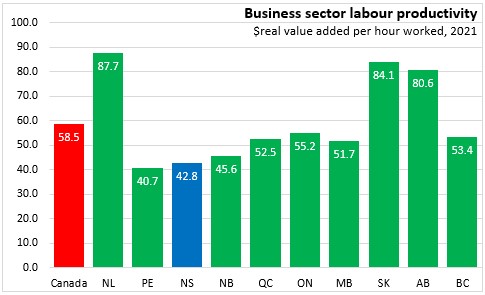
As economic conditions normalized in 2021. Nova Scotia's labour productivity still remained above its pre-pandemic level from 2019. Nova Scotia's labour productivity in 2021 was 3.9% higher than it was in 2019. Nationally, labour productivity was 2.3% higher than in 2019. Productivity gains over this period were strongest in the Maritimes and British Columbia while only Manitoba and Alberta report lower labour productivity in 2021 than in 2019.
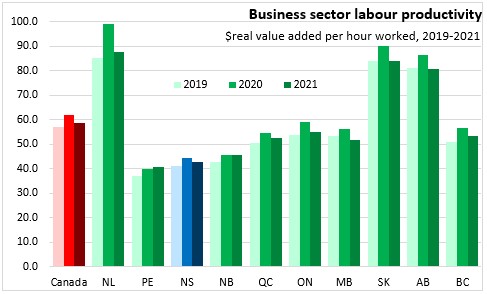
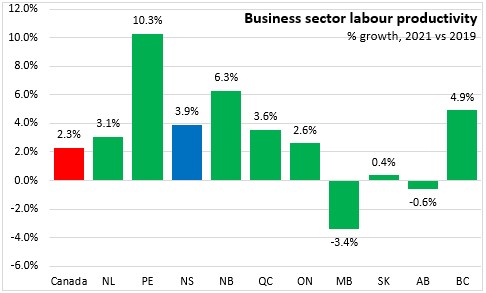
As COVID restrictions eased, there were strong rebounds in hours worked - particularly among those industries that had the sharpest declines during the first waves of the pandemic in 2020. Nova Scotia's business sector hours worked increased by 11.8%. National hours worked were up 11.5% with gains in every province. Alberta had the strongest gains while New Brunswick and Saskatchewan had the smallest increases.
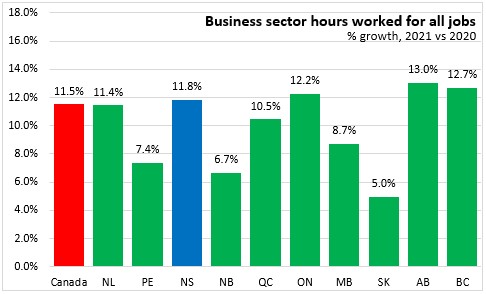
Although there was a rebound in hours worked in 2021, the overall level was still smaller than observed in 2019. Nova Scotia's hours worked in 2021 were 2.8% lower than in 2019. National hours worked were down 4.1%. No province reported higher hours worked in 2021 than in 2019. The largest gaps were in Newfoundland and Labrador and Saskatchewan. Manitoba's hours worked in 2021 were closest to their pre-recession levels.
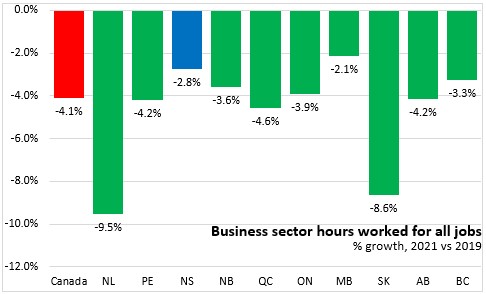
Nova Scotia's business sector real value added increased by 7.3% from 2020 to 2021 - the second fastest among provinces after Prince Edward Island. National business sector value added was up 5.0% with gains in eight provinces. Saskatchewan had the largest decline in business sector real value added.

Compared with 2019, business sector real value added was up for the Maritime provinces (1.0% in Nova Scotia) as well as in British Columbia. National real value added from the business sector remained 2.0% below pre-pandemic levels in 2021. Saskatchewan's business sector real value added was furthest from its pre-pandemic level.

Real value added can be approximated as the sum of changes in hours worked and changes in labour productivity (plus an interaction term that reflects the product of changes hours worked and changes in labour productivity).
Nova Scotia's labour productivity decline of 4.0% offset a 11.8% increase in hours worked (with a 0.5% interaction) to generate a 7.3% rise in business sector real value added.

In 2020, most of Nova Scotia's business sector industries reported lower hours worked. For most industries, reductions in hours worked were partially offset by gains in productivity. Rising productivity limited the reduction in real output despite reduced labour input. There were exceptions, in arts, entertainment and recreation; accommodation and food services; administration and business support; and transportation there were sharp reductions in hours worked as well as declines in productivity. Arts, entertainment and recreation as well as accommodation and food services reported the largest declines in real value added. These two industries were among the most restricted in 2020 due to the high-contact nature of their operations.
In 2021, almost all industries reported gains in hours and declines in labour productivity. There were increases in labour productivity for agriculture/aquaculture, support for agriculture/forestry, utilities, retail, and professional/technical industries. Hours declined in agriculture/aquaculture, support for agriculture/forestry, mining, support for mining/oil/gas, and utilities. The largest increases in hours worked were reported in fishing, arts/recreation and private education. The largest declines in productivity were reported in fishing, transportation and support for mining/oil/gas.
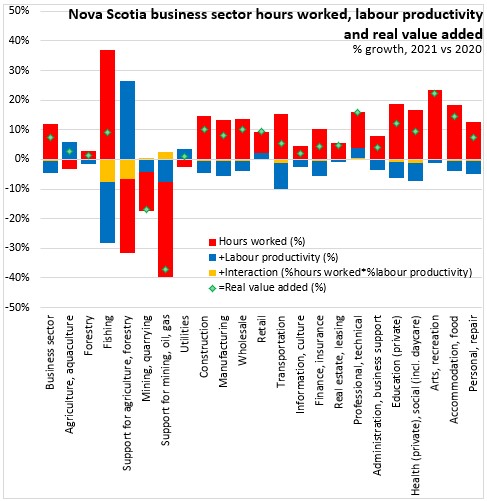
Compared with pre-pandemic levels from 2019, the largest increases in productivity were observed in support for agriculture/forestry (which also had the second largest decline in hours worked), followed by support for mining/oil/gas (largest decline in hours). The largest declines in productivity over the 2019 to 2021 period were reported in fishing, transportation, and arts/recreation.
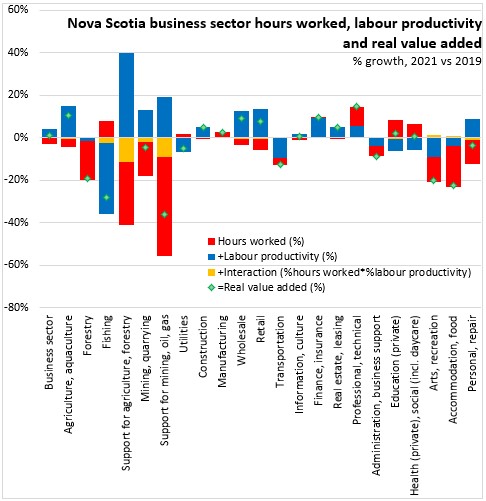
Nova Scotia's 2021 productivity decline was spread across both goods industry and services industry aggregates, though the declines in Nova Scotia were less than the national average.
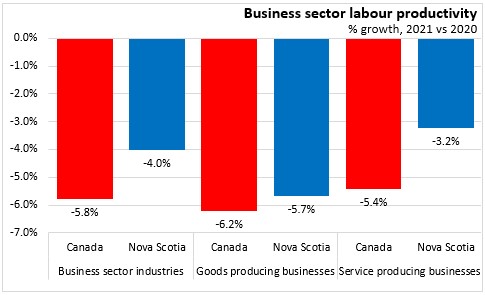
Compared with 2019, Nova Scotia's goods industries reported 1.1% lower productivity in 2021 while service industry productivity in Nova Scotia was 6.3% higher in 2021.
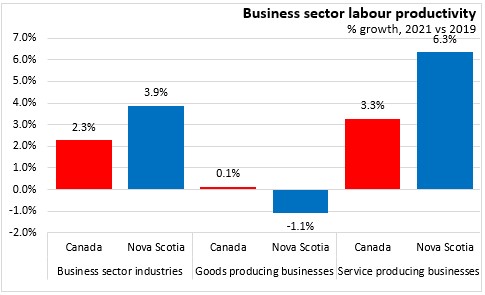
Although Nova Scotia's labour productivity growth outpaced the national average for services industries, the province's productivity levels remain well below national averages.
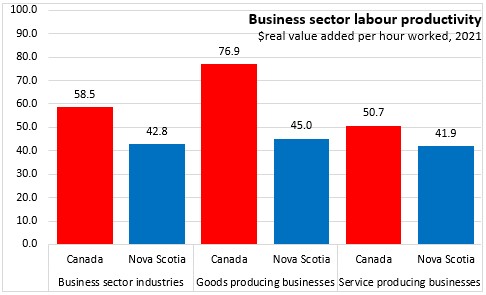
The distortions to labour productivity caused by the pandemic and recovery interrupted a trend of rising business sector real value added in 2020.

With much of Nova Scotia's 2021 employment gains among lower-wage industries that had the largest losses in 2020, overall compensation per hour worked declined 1.0%.
Business sector employee compensation per hour worked fell by 1.0% in Nova Scotia in 2021. National employee compensation was down by 0.8% with declines in 6 provinces - led by Alberta. Saskatchewan reported the largest rise in hourly employee compensation in the business sector in 2021.

Although employee compensation per hour worked fell in 2021, it did not offset the average increase observed in 2020. Nova Scotia's employee compensation per hour worked in 2021 was 11.8% above the 2019 level. National employee compensation was up 11.2% over this period with the fastest growth in Prince Edward Island, Quebec, and British Columbia. All provinces reported rising hourly compensation over this period, but Alberta's growth was the slowest.

Unit labour costs represent the amount of labour compensation required to generate $1 in business sector real value added. Unit labour costs rise when employee compensation per hour rises. Unit labour costs fall when labour productivity improves.
In 2021, Nova Scotia's labour productivity decline was larger than the fall in hourly employee compensation. As a result, unit labour costs increased by 3.2%. National unit labour costs were up by 5.3% with gains in eight provinces. The largest increases in unit labour costs were in Saskatchewan. Prince Edward Island and New Brunswick reported marginally lower unit labour costs in 2021 than in 2020.
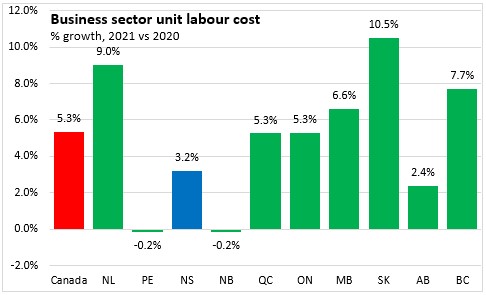
Business sector unit labour costs were $0.739 per $1 of real value added in Nova Scotia. This was the second highest, tied with Quebec and exceeded by British Columbia. National unit labour costs were $0.672 per $1 of real value added. The lowest unit labour costs were reported in resource-producing provinces (Saskatchewan, Newfoundland and Labrador and Alberta) reflecting the relatively low labour intensity of resource production.

Nova Scotia's unit labour costs have generally been highest among provinces, reflecting the Province's relatively labour-intense mix of output that is concentrated in service industries. Data for labour share are lagged by three years, so this reflects the pre-pandemic composition of production.
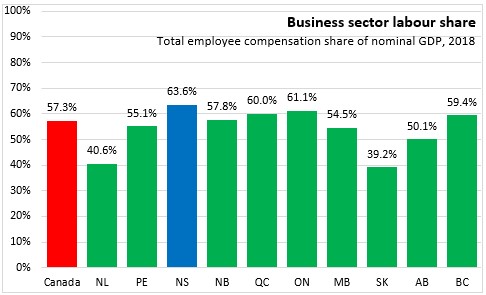
Between 2019 and 2021, unit labour costs increased 7.6% in Nova Scotia's business sector. National unit labour costs were up 8.7% with gains in all provinces. Saskatchewan reported the largest increases in unit labour costs over the pandemic and New Brunswick reported the smallest increase.
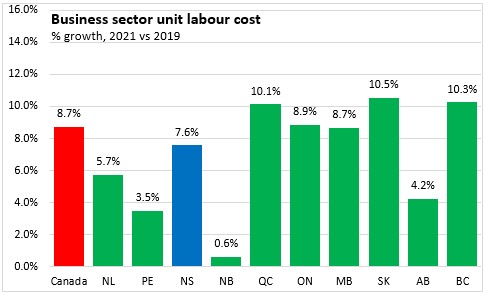

Source: Statistics Canada. Table 36-10-0480-01 Labour productivity and related measures by business sector industry and by non-commercial activity consistent with the industry accounts
<--- Return to Archive